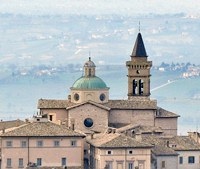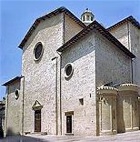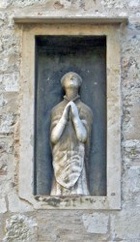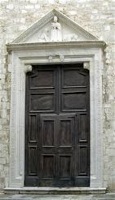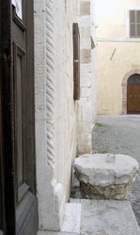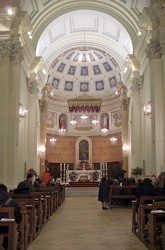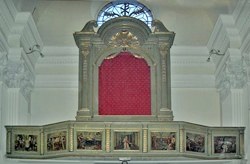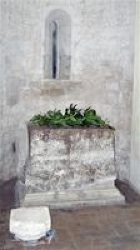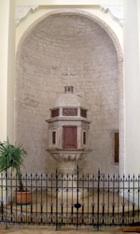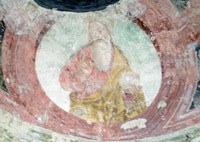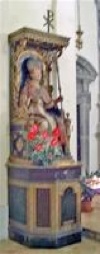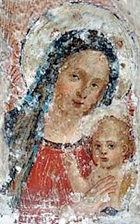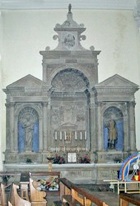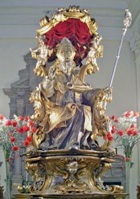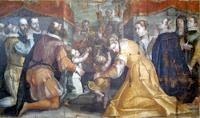This was probably the site of the burial of
St Emilianus in the 4th century. The relics were probably taken to Spoleto after the Spoletans destroyed Trevi in 1214. The earliest record of a church here dates to 1226: three small apses and part of its right wall survive as part of the present church (see below).
Another survival from the earlier church is a statue (13th century) of St Emiliano, which is contained in a niche above a closed portal in the east wall (to the right of the ancient apses in the illustration above).
The functions and possessions of San Martino della Pieve, the original parish church of Trevi (and the future site of the Observant Franciscan church of San Martino)passed to Sant’ Emiliano in 1430. The bells and clock from the Torre del Comune were moved to the campanile of Sant' Emiliano in 1461. The church was rebuilt on a larger scale from 1465. In 1485, probably when the rebuilding was complete, Pope Paul II raised it to the status of a canonical college. It was consecrated in 1522.
The Roman architect Luca Carimini largely rebuilt the church in the 19th century. The campanile was rebuilt in 1926, following an earthquake.
Portal
The portal (15th century) contains a relief of St Emilianus between two lions, a reference to the fact that he survived exposure to lions in the events that led up to his martyrdom. The coats of arms below belong to Marcello Petroni (dean of the canons) and Bishop
Costantino Eroli of Spoleto.
Part of a
Latin inscription was reused on the right. It commemorates Titus Varrutius, son of Titus and came from a monument (presumably his grave) erected by Vibusia, daughter of Lucius, his wife of 42 years. He was described as a Sabine and had held public office at Spoleto (as
quattuorviro,
aedile and
quaestor aerarii (Treasurer)) and at Norcia (as
ottoviro, with the power of
duoviro). Although only part of the inscription survives, it was recorded in full before it was incorporated into the portal.
This is one of only two Latin inscriptions found within the walls of Trevi: the other i was found in 2004 during the restoration of the pavement of San Francesco and is now in the Museo della Città e del Territorio.
Interior
The neo-classical appearance of the interior is due to the 19th century re-modelling.
Counter-facade
Martyrdom of Sant' Emiliano (17th century)
Six panels with scenes from the martyrdom of St Emilianus can be seen in the choir above the main entrance. They probably date to the period after 1660 when the cult of the saint was revived.
Right Wall
As noted above, the first three chapels on the right survive from the original church.
Original Right Apsidal Chapel
This chapel (now the 1st on the right) contains the relics of St Emilianus, which were rediscovered in the
Duomo, Spoleto in 1660 and translated here in 1935.
Original Apse
This chapel (now the 1st on the right) contains the baptismal font (15th century). An extract from the baptismal records of the Duomo, which is reproduced here, records the baptism of the future
St Antony Fantosati here in 1842.
Original Left Apsidal Chapel
Virgin Annunciate God the Father St Emilianus
This chapel is walled in, but accessible by the door on the right in the adjacent Cappella della Trinità. It contains frescoes (ca. 1510) that are attributed to Francesco Melanzio da Montefalco.
St Emilianus Enthroned (17th century)
This polychromed wooden statue is just before the crossing. It probably dates to the period after 1660 when the cult of the saint was revived. Until its replacement ca. 1753 (see below), it was taken in procession on the saint's feast day (27th January) during the Processione dell' Illuminata, a celebration that goes back to at least the 13th century.
Left Wall
Madonna della Colonna (ca. 1510)
This fragment of a fresco of the Madonna and Child, which is attributed to
Francesco Melanzio da Montefalco, was moved here from its original location on a column in the original church.
Altar of the Sacrament (1521-5)
The Confraternita del Sacramento commissioned this altar (the 2nd on the left) from
Rocco di Tommaso da Vicenza, using a bequest from Virginia Procacci. The altar was recomposed here after the rebuilding of the 19th century. The figures of the Virgin and St Joseph in the niches are by
Mattia di Gaspare da Como. The reliefs of angels to the sides of the tabernacle (behind the candles in this photograph) are particularly fine.
Processional statue of St Emilianus (1753)
This gilded wooden statue of St Emilianus enthroned was carved in Foligno by
Pietro Epifani. It is only displayed for a few days around the 27th January, the day on which it is used for the Processione dell' Illuminata.
Art from the Church
Madonna of the Rosary (16th century)
This panel formed the lower part of a huge altarpiece that Muzio Petroni commissioned for an altar in Sant' Emiliano that belonged to the Compagnia del Rosario. It entered the civic collection in 1878 and is now in the Pinacoteca.


